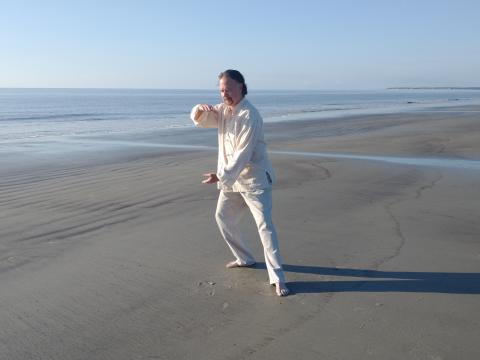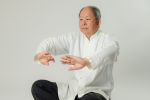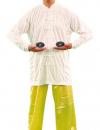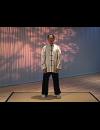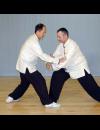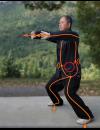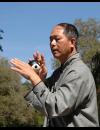Tai Chi and Qigong for Arthritis and Pain
June 3, 2024
Hypoxia, which is an oxygen deficiency in the tissues, underlies or complicates almost every health condition. This is the reason I have proposed the term Metarobic exercise to describe the effects of Tai Chi and related exercises on the body. 9 Min Read
Theory of Taijiquan and Health
May 20, 2024
Though the martial side of Tàijíquán is for strengthening the physical body and for defense, the scholarly side of Tàijíquán is for understanding human nature and comprehending the meaning of life. Only if (you) can cultivate these, both internally and externally, can you reach the Dào of balancing physical body and mind, and (also) the dual cultivation of human nature and physical body.
8 Min Read
Bring Your Body Into Balance
May 6, 2024
Slow, Deep breathing stimulates the main nerve of the parasympathetic nervous system called the vagus nerve, which in turn releases hormones and neurotransmitters that slow your heart rate, lower your blood pressure and generally brings your body into balance.
5 Min Read
The Power of Mass Tai Chi Recitals
April 29, 2024
In honor of World Tai Chi & Qigong Day 2024, YMAA Staff Writer Gene Ching examines tai chi demonstrations done in large groups. 6 Min Read
Five Regulators of Taijiquan
April 8, 2024
What is Tàijíquán? It is a martial Qìgōng study. Its training procedures are not different from those of other general Qìgōng (practice) and must follow the (same training) theory. These training procedures are nothing else but: regulating the body, regulating the breathing, regulating the mind, regulating the Qì, and regulating the spirit—five regulatings.
7 Min Read
Saga of the Chinese Sword
-
July 13, 2015
The ancient Chinese regarded the sword as a very important weapon, as evidenced by the relatively large number of documents about it and the frequency with which swords turn up in archeological digs. It is the only weapon that has been used and admired continuously from the beginning of Chinese history to the present day.
On Practicing Taijiquan—The Five Mindsets
-
June 29, 2015
Many people are aware that taijiquan is beneficial, but to obtain those benefits one needs "samutpada" (arousal of earnest intention) and one has to pay the price. Everyone can afford it, but most people are reluctant to pay. Whenever I run into taijiquan enthusiasts who want to practice taijiquan with me, what I first say is, "If you want to learn taijiquan you need to pay the price.
Mind Approach in Practicing Taijiquan
-
June 22, 2015
The Mind Approach in Practicing Taijiquan. The mind approach is a way of practicing with one's heart (mind and intent) as the guidance. It used to have no fixed patterns or rules; however, the mind approach I present has its principle based on the following six points.
What's It All About? Tai Chi
-
May 25, 2015
Each day, millions of men and women worldwide practice the Chinese martial art Tai Chi Chuan (taijiquan), which has been known for centuries to promote deep relaxation, excellent health, and to prevent injuries and illness. This gentle moving meditation teaches you to find balance between strength and flexibility, increases bone density, while involving all of the various soft tissues in your body: muscles, tendons, ligaments, fasciae, and skin.
Moving Taiji Qigong
-
May 15, 2015
Moving taiji qigong includes both stationary and walking exercises. The following discusses the first of three stationary sets with exercises. The first one, which I call the “primary set,” is generally used for taijiquan beginners. I call the second set the “coiling set,” since it emphasizes coiling movements. The third set is the “rocking set.”
One World, One Breath: An Interview with Bill Douglas, founder of World Tai Chi Day & Qigong Day—Part 2
-
April 20, 2015
I recently spoke to Bill Douglas, founder of World Tai Chi and Qigong Day, about his experience with this amazing global event. Here is Part 2 of the interview. See April 13, 2015 for Part 1.
One World, One Breath: An Interview with Bill Douglas, founder of World Tai Chi Day & Qigong Day—Part 1
-
April 13, 2015
World Tai Chi & Qigong Day (WTCQD) will be celebrated on April 25, 2015 at 10 a.m. in every time zone around the world. You can participate in this global day of peace by yourself or with your local tai chi group by simply practicing at 10 a.m. As the day passes, a wave of energy will encircle the globe through the hearts and minds of practitioners on every continent.
Power Training for Tai Chi Sword
-
April 6, 2015
According to Chinese martial Qigong, the power is first generated from the mind. From the mind, the Qi is led to the physical body to manifest it as power. Therefore, we can see that the Qi is the energy, while the physical body is like the machine. A detailed explanation of Qigong can be found in the YMAA book The Essence of Shaolin White Crane.
About Pushing Hands—Part 2
-
March 30, 2015
An (Press or Push Down) means to settle the wrist. It is executed by using the base of the palm, either one palm or both palms can press and push. An can be divided into offensive An and defensive An. In offensive An, the base of the palm is used to push upward to the chin to destroy the opponent's central equilibrium; to the throat to seal the opponent's breath; to push forward to Xinkan (Jiuwei) (i.e., solar plexus area) to seal the breath as well as destroy the opponent's central equilibrium or shock his heart; to push downward to the abdominal area to destroy the stability of the lower part of his body or to seal his breath.
About Pushing Hands—Part 1
-
March 23, 2015
Practicing Methods of the Four Directions and Four Corners (Eight Doors, Eight Trigrams). What are the four directions and four corners? They are the eight doors. It is also the theory of Eight Trigrams in Taijiquan. What are the four directions?
Basic Taiji Theory
-
March 16, 2015
If we desire to understand taiji theory, then we must first trace back to its origins and roots. Only then will we know how and where it came from. Although a great proportion of Chinese martial arts history is vague, we can still trace it with some accuracy and in some detail.
Four Applications of Taiji Ball Qigong (太極球氣功之應用)
-
December 15, 2014
At this stage, you should be able to practice the circling, rotation, and wrap-coiling patterns smoothly. You should also be able to perform each of these patterns comfortably while stationary, rocking, stepping, and bagua stepping.
Nèigōng: Martial Qìgōng for Internal Power
-
December 8, 2014
The traditional Chinese art of Nèi-gōng is the key to developing more qì (energy) and maximizing your circulation. Continual practice of Nèigōng is a process of internal alchemy resulting in a refinement and transmutation of the "Three Treasures" or Sān Bǎo (三寶).
Regulating the Breath (Tiao Xi)
-
November 24, 2014
Regulating breathing means to regulate your breath until it is calm, smooth, and peaceful. Only when you have reached this point will you be able to make the breathing deep, slender, long, and soft, which is required for successful qigong practice.
What is Qin Na?
-
November 17, 2014
Taijiquan (太極拳) was originally developed for combat in ancient times. Its fighting theory is to use the soft against the hard, and to use the round to neutralize the straight or square. In order to achieve this goal, the body must be soft and the movements must be smooth and natural. Taijiquan also emphasizes the cultivation of qi (氣), or internal energy.
The Sword Way
-
October 20, 2014
In ancient China, the way of the sword was widely respected. This was so not just because sword techniques and skills were difficult to learn. The main reason was that moral and spiritual qualities were required in order to attain the highest levels of its art.
Acupuncture Points Verified with New Technology
-
September 8, 2014
Acupuncture is the art of stimulating points in the body to improve circulation and remove blockages, either as a general tonic or to promote the healing of specific ailments.
Action of the Five Building Blocks of Qi (Energy System)
-
August 25, 2014
In order to achieve a strong energetic system, we must fine-tune each of the five building blocks until fine-tuning is not necessary.
Improving Quality of Qi's Manifestation
-
July 21, 2014
Here we will discuss how the quality of qi's circulation or manifestation can be improved. First, we should recognize that from Chinese martial art history, it was not until the fifth century that Chinese internal styles were developed, recognized, and practiced.
Guidelines for Taijiquan Practice
-
May 12, 2014
To successfully learn taijiquan (tai chi chuan), you will need to understand some of the principles and guidelines that have accumulated over the centuries by masters of this ancient art. These principles and guidelines are the foundation of taijiquan.
